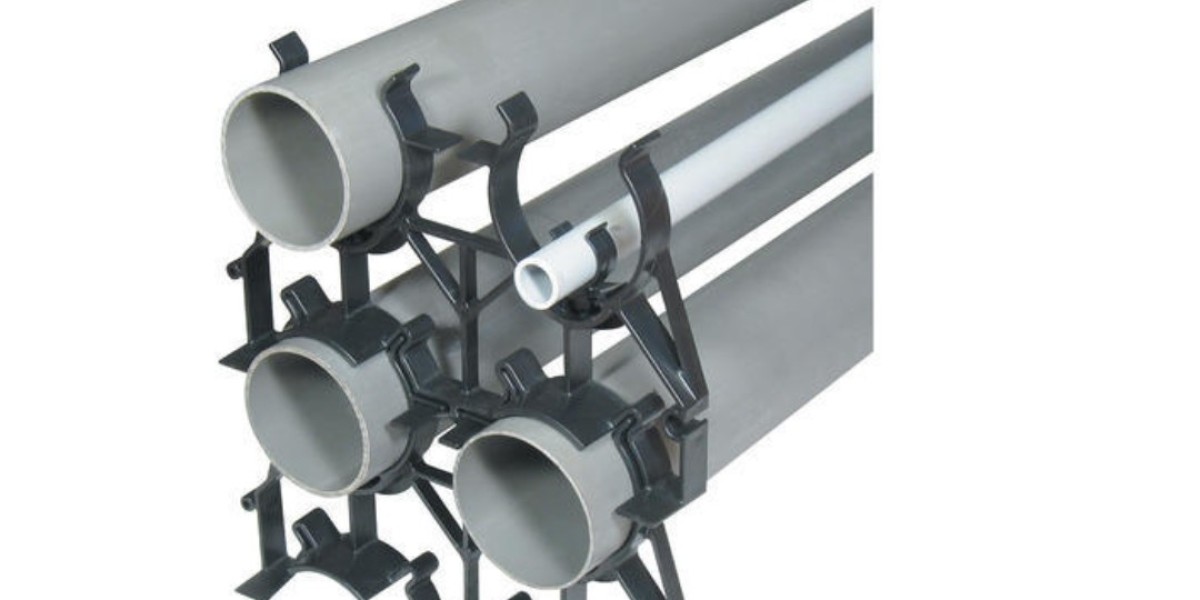In modern infrastructure, underground conduit systems play a crucial role in protecting and organizing cables and pipes for electrical, telecommunications, and other utilities. A critical component that ensures these systems are arranged safely and efficiently is the HDPE Duct Spacer. These spacers are designed to create and maintain a consistent separation between ducts within conduit systems, preventing tangling, damage, or interference among the ducts.
In this article, we will discuss what HDPE Duct Spacer Dimensions are, their importance in various conduit installations, the benefits of using them, and their applications. We’ll also address common questions about HDPE duct spacers, helping you gain a comprehensive understanding of their role in ensuring efficient conduit systems.
What Are HDPE Duct Spacers?
HDPE Duct Spacers are components used to organize and separate multiple ducts or conduits in an underground or above-ground conduit system. These spacers are typically made from High-Density Polyethylene (HDPE), a durable thermoplastic known for its strength, flexibility, and resistance to chemicals and environmental conditions.
HDPE duct spacers are designed to maintain the proper alignment and spacing of ducts or pipes, which is essential for cable management in utility and communication networks. By maintaining a consistent gap between ducts, these spacers prevent the ducts from collapsing or shifting during installation and after backfilling.
Duct spacers are available in various configurations and sizes, making them adaptable to different conduit layouts, whether for power cables, telecommunications, or water piping systems. Their modular design allows for easy installation and adjustment, contributing to a more organized and long-lasting conduit network.
Key Features and Benefits of HDPE Duct Spacers
Durability: HDPE is known for its high strength-to-density ratio, which means it can withstand significant loads without deforming or breaking. HDPE duct spacers are resistant to chemicals, corrosion, and environmental factors, making them suitable for both underground and exposed conduit systems.
Flexibility: HDPE duct spacers are flexible and can be used in various applications, from electrical and telecommunications to water and gas piping systems. Their adaptability ensures proper alignment in different configurations, even in curved or uneven trenches.
Ease of Installation: The modular design of HDPE duct spacers allows for easy assembly and disassembly. Installation is typically fast, which reduces labor costs and minimizes disruption during the construction process.
Cost-Effective: HDPE duct spacers are affordable and have a long service life, making them a cost-effective choice for conduit systems. Their durability also reduces the need for maintenance and replacement, further lowering costs.
Chemical Resistance: HDPE is resistant to most chemicals, making duct spacers made from this material suitable for use in harsh environments where chemical exposure may occur.
High Impact Resistance: HDPE duct spacers can withstand impacts and external pressures, which makes them highly suitable for underground installations where heavy loads from soil, construction equipment, or traffic may be present.
Lightweight: Compared to metal spacers, HDPE duct spacers are lightweight, making them easier to handle and transport. This feature not only facilitates installation but also reduces shipping costs.
Environmental Resistance: HDPE duct spacers are UV-resistant and can withstand exposure to varying weather conditions. This makes them ideal for both underground and above-ground installations.
Applications of HDPE Duct Spacers
HDPE duct spacers are widely used in various sectors due to their versatility and durability. Some common applications include:
1. Electrical Conduits
In electrical systems, HDPE Duct Spacer India are used to organize and separate electrical conduits containing power cables. These spacers ensure that the conduits remain aligned, preventing damage to the cables during installation or operation. Proper spacing also improves the performance of the electrical system by reducing interference and overheating.
2. Telecommunications
Telecommunication networks require organized and protected conduit systems for fiber-optic cables and other communication lines. HDPE duct spacers help keep these conduits separate, minimizing the risk of signal interference and physical damage. They are often used in both underground and aerial conduit systems.
3. Gas and Water Piping Systems
HDPE duct spacers are also used in gas and water piping systems. They help maintain consistent spacing between pipes, ensuring that the system functions efficiently without the risk of pipes shifting or collapsing. This is especially important in pressurized systems where pipe alignment is critical.
4. Infrastructure Projects
In large infrastructure projects such as roadways, bridges, and tunnels, HDPE duct spacers are used to organize and protect multiple conduits running through the same trench or duct bank. These spacers are essential for maintaining a structured conduit layout, which simplifies maintenance and repairs.
5. Renewable Energy Installations
HDPE duct spacers are commonly used in renewable energy projects such as solar farms and wind energy installations. These projects often require large conduit systems to manage electrical and communication cables, and HDPE duct spacers help ensure that these systems are organized and efficient.
Environmental Considerations
As the world moves towards more sustainable and environmentally friendly practices, the use of HDPE duct spacers aligns with these goals. HDPE is a recyclable material, which means that old or unused duct spacers can be collected, recycled, and reprocessed into new products. This reduces the amount of plastic waste in the environment and conserves resources.
Additionally, HDPE's long service life means that it doesn't need to be replaced as frequently as other materials, further reducing its environmental impact.
Choosing the Right HDPE Duct Spacer
Selecting the appropriate HDPE duct spacer depends on several factors, including:
- Conduit Size: The spacer must be compatible with the diameter of the ducts or pipes being used.
- Spacer Configuration: Different projects require different spacer configurations. Some spacers are designed for single-layer conduit systems, while others are meant for multi-layer installations.
- Load Requirements: Consider the external loads that the conduit system will be subjected to, such as soil pressure or vehicular traffic, and choose a spacer that can withstand these forces.
- Installation Environment: HDPE duct spacers are suitable for various environments, but some conditions may require spacers with additional features, such as enhanced chemical or UV resistance.
Conclusion
HDPE Duct Spacers play a vital role in ensuring the efficiency and organization of conduit systems used in various industries, from electrical and telecommunications to water and gas utilities. Their strength, flexibility, and resistance to environmental factors make them an ideal choice for conduit installations of all sizes and complexities. By maintaining proper spacing and alignment, HDPE Duct Spacer In Construction help extend the life of conduit systems, improve performance, and reduce maintenance costs, making them an essential component of modern infrastructure projects.
Frequently Asked Questions (FAQs)
Q1: What is the purpose of a duct spacer in a conduit system?
A: The primary purpose of a duct spacer is to organize and maintain the proper alignment and spacing between conduits or ducts in an underground or above-ground system. This ensures that the ducts remain in place during installation and operation, preventing tangling, interference, and damage.
Q2: Can HDPE duct spacers be used in all types of conduit systems?
A: Yes, HDPE duct spacers are versatile and can be used in various conduit systems, including electrical, telecommunications, gas, and water piping systems. Their flexibility and adaptability make them suitable for a wide range of applications.
Q3: How are HDPE duct spacers installed?
A: HDPE duct spacers are typically installed during the laying of conduits. The spacers are positioned at regular intervals along the trench or duct bank, and the conduits are placed into the spacer slots. The modular design of HDPE duct spacers allows for easy assembly and adjustment during installation.
Q4: Are HDPE duct spacers environmentally friendly?
A: Yes, HDPE is a recyclable material, and duct spacers made from HDPE can be recycled at the end of their life cycle. Additionally, HDPE's durability reduces the need for frequent replacement, contributing to lower environmental impact.



